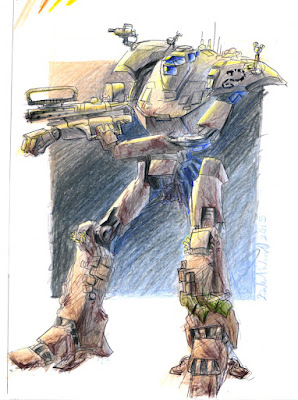1. What kind of story am I telling?
2. What is the theme (visual and narrative) of the story? How is the idea connected to this?
3. Where does this idea fit in the story? Whose side is it on?
Whether these questions are asked and answered consciously (like a list) or intuitively (like arranging shapes and seeing what meanings or images or additional ideas they bring to mind), the point is they are answered somehow. And this brings me to the point of today's post: how I developed these "sky-ships" and how I might develop them further.
So, the sky-ships. Let's put this idea through the list above and see what we get.
1. The sky-ships in question are part of an action/adventure-military-sci-fi story that is currently itself mostly ideas and a few written fragments. These ships are primarily intended for combat in the atmosphere of their planet. Whether they can go into outer space I haven't decided yet.
2. The theme of the story with the sky-ships is partially complete; it would focus around naval combat (in the sky, of course) and typical air combat (fighter planes and such). The tone is heavily slanted towards the "military" in military sci-fi.
3. The sky-ships in question–the shark-shaped ships and WW2-era ships with wings–are the good guys.
4. With these particular ships, I want them to have the clean, sleek, fiercely predatory lines of sharks (less obvious in the WW2 ships, way more obvious in the shark-ships). I want them to look aggressive and threatening, no soft goody-two-shoes vibes here. They're military ships, after all. They kill to defend their nation. It's their job.
Another concern is the tech level of the story; I haven't yet decided whether I want it to be "retro-future" with historically-inspired ships, or just out-and-out-distant-crazy-future-shark-ships. This is just an exercise, however, we don't need to chase all the rabbits down their rabbit holes...not yet.
With this in mind, I can condense all this information into a few key points to describe the ships to myself:
- Sky-ships: need to look sleek enough to fly, powerful enough to force their way through the air, or both.
- Military sci-fi: matte colors, camouflage patterns, few frills or ostentatious decorations, use real-world naval vessels and vehicles for weapons and technical greebles, make obvious differences between different classes of ships.
- Good guys: ships in good/clean condition (with appropriate weathering), sense of order and discipline on ships, flags flying clean and proud and well-kept, use shapes that are appealing and are not unnatural and strange.
- Aggressive: sleek lines coming to sharp points, take inspiration from sharks and real-world ships, use basic shapes to create impression ship is lunging forward, mount weapons nearer to bow of ship, use basic and secondary shapes to evoke aspects of predatory animals or weapons, repeated use of triangular shapes (sharp and aggressive).
The result of these considerations, conscious and unconscious, were multiple pages of idea-dumping sketches, where I simply drew out any concept that seemed related to the project. The two pictures above are examples of that. After that, I had the chance to look over the various sketches, pick the ones that really fit my idea, and refine them. And that's how I got two particular pages of sketches, one of the retro-future WW2 ships, one of the shark-ships.
The retro-future WW2 ships give the impression of being heavier, less advanced designs, vessels that have some streamlining, but mostly rely on sheer engine power to take flight. They would be suitable for a retro-future setting, something I very much want to write.
The shark-ships, with their sleek, modern lines and streamlined mass, have a more futuristic feel to them. These are the ones I would more likely write up as being capable of spaceflight.
Most of the time, this process takes place semi-consciously or unconsciously, right when I'm drawing in my sketchbook. I'll build up ideas I like, and if I can connect them to a story, or see a potential story in them, I'll take the next step and start consciously developing them to fit into a narrative.
I hope this helps you with creating and developing your ideas. See you next week.





























